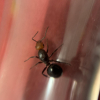So I have a fairly large tank that I'm planning on turning into a vivarium for my F. subsericea colony. I don't have the exact dimentions, but it's something like 1.5 feet by 1.5 feet by 3 feet. I was thinking of making it a sandy vivarium. In my opinion, this has a couple advantages. One, it will be easier to see the darkly colored ants against the light ground. Two, I know that they like sand. I caught them at a beach of a small lake. There were two F. subsericea nests within 10 yards of each other. One of the days I visited, there happened to be a flight taking place. One of the nests only produced queen alates while the other only produced males. So I know that they like sand as a nesting medium.
But I was wondering how exactly to do this. All the results I get when I search for how to build a sandy terrarium were for desert terrariums. The one I want to make is more of a beach terrarium, since that's where I found the queen and the mother colony. Also, what other insects should I add? And what are some good plants that grow in sand (other than succulents and cacti)? This beach was small, only like 4 yards from the water to where it met forest. The nest was right on the edge of the forest, so maybe I could make a corner of the vivarium soil? Please help, and feel free to leave suggestions!




















